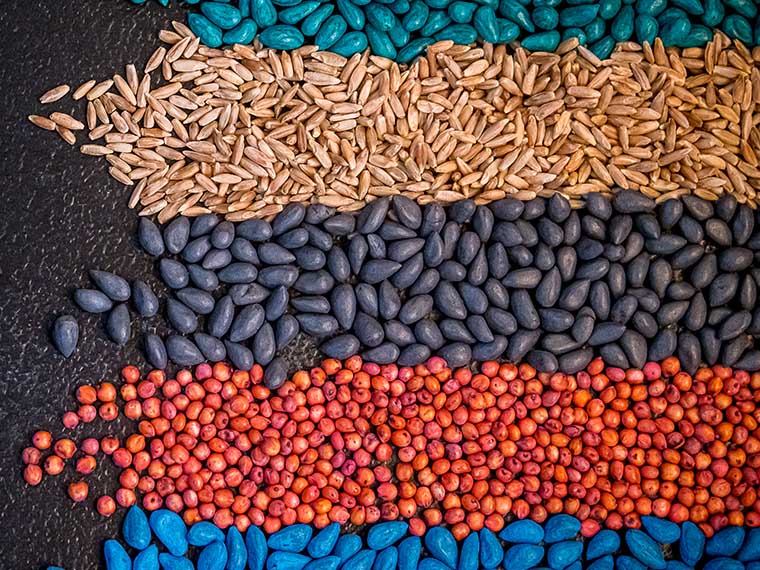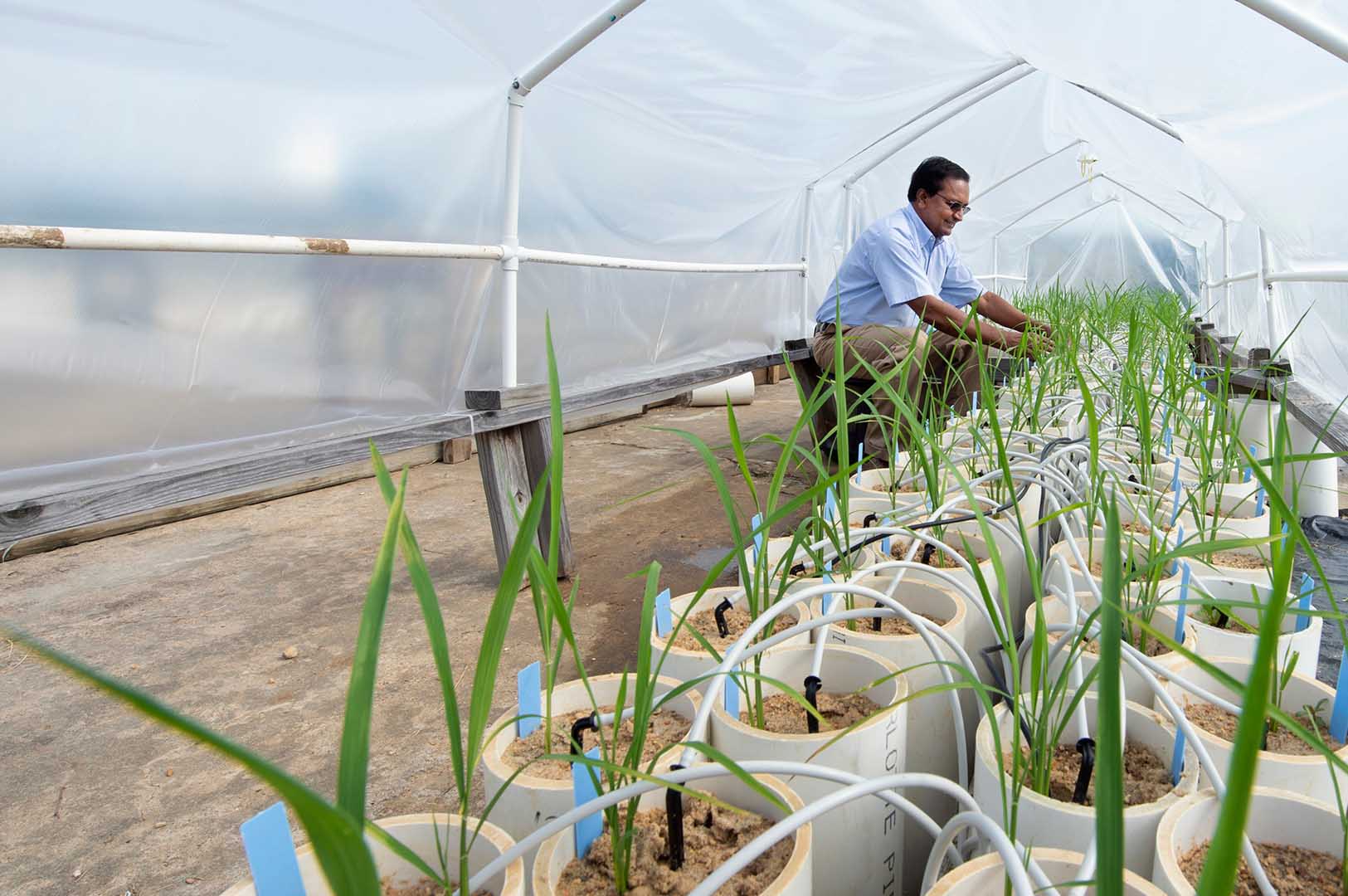The information presented on this page may be dated. It may refer to situations which have changed or people who are no longer affiliated with the university. It is archived as part of Mississippi State University's history.
IN 2019, the U.S. harvested 3.56 billion bushels of soybeans across 75 million acres spanning 31 states. That same year, the country saw an estimated 2.47 million rice acres harvested across six states yielding 185 million hundredweight of grain. Any bountiful harvest begins with simple seeds and seeds, like most living things, rely on parents and a number of other factors in order to grow healthy and strong. That's why researchers in the Mississippi Agricultural and Forestry Experiment Station are studying what can impact the germination of seeds and early seedling vigor.
Dr. Raja Reddy, a research professor in the Department of Plant and Soil Sciences and director of the Soil-Plant-Atmosphere-Research unit, investigates how parental season growth temperature and drought stress treatments affect post-seed germination and early seedling growth in soybeans.
"We're interested in how the abiotic stress a parental plant endures affects the seed as it germinates and grows into a seedling," Reddy said.
In exploring the transgenerational effects of temperature and drought stress in soybeans, the team reduced optimal soil moisture 100, 80, 60, 40 and 20 percent for maternal parents and evaluated under controlled conditions at various temperatures during reproductive growth. Researchers found that the effects of soil moisture stress or high temperatures on the parents caused a reduction in the speed at which seeds germinate, in the overall viability of the particular seed population, and the overall performance of the seedlings in the first generation.
Reddy pointed out that the reduction in germination rate, population, and stunted seedling growth were further exacerbated when the seeds and seedlings themselves were exposed to drought- and low and high temperature-like conditions.
"We collect seeds from the respective parental environments and then grew them under varying conditions. When we grew them at optimal conditions, you may see a slight reduction in germination and seedling vigor, but when we grew them in less than optimal conditions, the parental effects are much more pronounced, resulting in large impacts," Reddy said.
Reddy said the data confirms that the effects of soil moisture and temperature stresses on soybean are transferable.
"We're finding that optimal water supply during the soybean seed formation period may be beneficial for seed producers in terms of optimizing seed quality and vigor characteristics of commodity seeds."
Reddy said the ultimate goal of the research is to better understand the best conditions and areas for seed production.
"The effect of the environment has serious ramifications for seed production and multiplication. Our data indicate that seed produced in environments where drought or high temperature occurs during or through the reproductive stages is deleterious to seed production and multiplication," Reddy said.
While the team also plans to study how seasonal growth temperatures of the parent affected post-season seed germination and seedling growth in rice, current rice research is focused on evaluating cultivars that can withstand temperature and moisture differences. Reddy, along with Dr. Ed Redoña, a research professor at the Delta Research and Extension Center and MAFES rice breeder, have evaluated different cultivars to determine which can be developed to withstand harsher climates.
"Dr. Redoña selected 100 temperate and 75 tropical rice lines to evaluate in order to find ways to crossbreed for improved drought and heat tolerance," Reddy explained. "We're trying to quantify how these 175 lines will respond to high and low temperatures and drought and then assign a numerical score for each variety, so you can take two high scoring lines and develop a new variety based on producer needs."
Redoña said temperature was one of the key environmental stress factors that affect various stages of rice plant growth and development.
"In the Midsouth, rice plants get exposed to variable temperatures depending on the planting date. Rice cultivars vary in their response to temperature and developing a method for identifying tolerance to both low and high temperatures will be helpful not only for research and breeding but also for selecting existing varieties already in use by rice producers," Redoña explained.
He said thus far, the team has conducted several experiments with results that have helped identify key parameters that can be used for early season vigor and low- and high-temperature tolerance and drought tolerance.
"We have also identified specific released varieties or hybrids with tolerance to extreme temperature conditions that can already be used in commercial production in Mississippi as well as the identification of new genetic donors that can be used in breeding to develop temperature stress tolerance in future rice varieties," Redoña explained.
The ultimate goal of the work is to develop cold-tolerant rice varieties that can grow well even when planted earlier than mid-April, which is the current optimal planting data in Mississippi.
Redoña pointed out that earlier planting means the plants avoid stress brought on by high temperatures in August when the critically sensitive flowering stage in rice occurs.
"These high temperatures have resulted in more than a ten percent reduction in yield for Mississippi rice in the past several years," Redoña said. "Even better, incorporating high-temperature tolerance along with cold tolerance into future varieties would make Mississippi rice climate-resilient and climate-proof as far as temperature is concerned."
When it comes down to it, Reddy said the team's research in developing resiliency in seeds would ultimately help growers feed, clothe, and fuel the world amid a changing climate.
"Seeds are one the largest costs for farmers. Oftentimes, we must plant early in the season when the temperature isn't ideal for the seed to germinate. We hope to continue to find ways to breed seeds that are more tolerant to abiotic stressors while also finding ways to model ideal geographic locations for seed production," Reddy said.
This research was funded by the Mississippi Soybean Promotion Board, the Mississippi Rice Promotion Board, the Mississippi Agricultural and Forestry Experiment Station, and USDA National Institute for Food and Agriculture.
The effect of the environment has serious ramifications for seed production and multiplication. Our data indicate that seed produced in environments where drought or high temperature occurs during or through the reproductive stages is deleterious to seed production and multiplication
Dr. Raja Reddy


